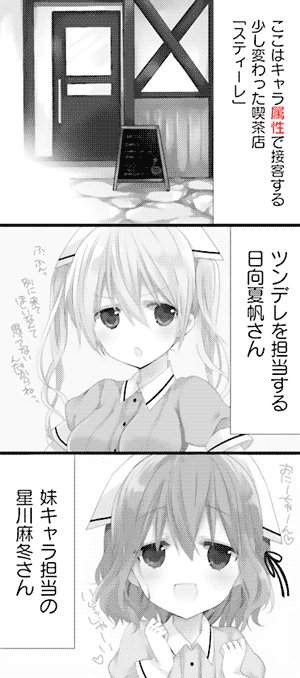Basically, it refers to a fetish, but the term "fetish" carries a sexual connotation, which isn't necessarily the case with moe attributes.
For example, if you like characters that wear "glasses," megane 眼鏡, then you're "glasses-attribute," megane-zokusei 眼鏡属性. Conversely, a character that's designed specifically to appeal the glasses-loving folks is also said to be megane-zokusei.
Meaning
The term zokusei 属性, "attribute," comes from Japanese RPGs like Pokémon, in which using an attack of the correct attribute can be super effective specific certain enemies. For example: using fire-attribute attacks against plant-based enemies to deal extra damage.Similarly, within the Japanese anime fandom, zokusei has been a term to refer to something someone likes in the design of characters or situations in stories.
The love of fans for these "attributes" is practically unconditional, such that no matter how bad the anime is they will still like the characters that feature their favored attributes.
A girl that has horns and fangs, for example, is super effective at gaining popularity among fans that like such designs, no matter how bad the anime she's featured in ends up being.
As far as usage is concerned, moe youso 萌え要素, "moe element," refers to a definable feature that might be considered moe by someone, while zokusei refers to a preference toward an element, or a design which is meant to emphasize that element.
To elaborate: all characters that wear glasses ends up having glasses as a moe element, but only some characters are designed to wear glasses for the sake of appealing the glasses moe attribute.
Distribution Strategy
A commonly employed strategy by authors is to create varied characters that cover the most number of moe attributes possible. Such strategy results in two things easily observable in most harem and CGDCT anime:- There's an out-of-place character that's been forced into the story to cover a popular attribute.
- There are never two characters made to cover the same single attribute.
There's one, and always only one tsundere ツンデレ. There's one, and always only one ojousama お嬢様. There's one, and always only one otokonoko 男の娘. And there's always at least one girl with small breasts and one with large breasts.
Well, depending on the theme of the work, there might be more. For example, some works are focused on rich girls, so there are more ojousama characters, but in that case the whole work is ojousama-zokusei. But, in general, it's only one.
Notable Examples
Virtually everything that has a name, and even things that don't even have a name, can be a moe attribute. From hair color, to eye color, to having two eyes of different colors.Since fiction isn't reality, you also end up with things that you can only name in fiction, like characters that have black sclerae, or that have three eyes.
Attributes aren't limited to physical appearance. It also includes whole genres, like kemono 獣 and monster girls.
Attributes can also be situations. The sort of relationship two characters have: like oneshota おねショタ, when an older girl, an oneesan お姉さん, is paired with a little boy, a shota ショタ.
These can become incredibly complex. See: types of seme and uke. In particular: gekokujou 下剋上 refers to a scenario in which the roles of seme and uke are attributed to characters of inverse power: e.g. the boss is uke and the employee is seme, or the master is uke and the slave is seme.
Clothing of all sorts in all sorts of ways also counts as attributes: from cat ears, to wearing nothing but an apron, to a girl wearing a backpack or something such that the strap crosses her chest diagonally emphasizing her breasts, to even the specific space of bare thighs between knee-high socks and a mini-skirt.
Lastly, any character or scenario that has two contradictory features in juxtaposition is a moe attribute by itself: gap moe, for example: a cold-blooded assassin that can't resist petting cats because they're so cute, or, conversely, a cute creature that's actually a cold-blooded monster.
Meta
Some manga and anime have moe culture and otaku オタク as a central topic, and end up having moe attributes as an important part of the work. For example:
Manga: Blend S, ブレンド・S (Volume 1, Page 25)
- koko wa kyara-zokusei de sekkyaku suru sukoshi kawatta kissaten "Suthiiru"
ここはキャラ属性で接客する少し変わった喫茶店「スティール」
[Café "Stile" is a bit weird place where employees serve customers using character attributes.] - tsundere wo tantou suru Hinata Kaho-san
ツンデレを担当する日向夏帆さん
Tasked with tsundere, Hinata Kaho-san. - fufun betsuni kite hoshii nante omottenai-n-dakara ne
ふふん 別に来てほしいなんて思ってないんだからね
[Hmph, it's not like I wanted you to come or anything, okay?] - imouto-kyara tantou no Hoshikawa Mafuyu-san
妹キャラ担当の星川麻冬さん
In charge of the younger sister character, Hoshikawa Mafuyu-san. - oniichaan♡
おにーちゃーん♡
Brother♡
Another example:
- Ore, Twintail ni Narimasu.
俺、ツインテールになります。
Features a protagonist with a twintails-attribute, fighting villains that have all sorts of other attributes, including even the notorious glasses-attribute.

No comments: